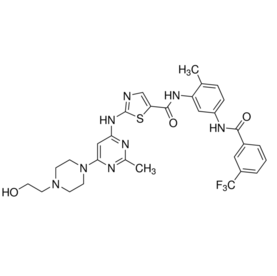| Description: |
UM-164 is a highly potent inhibitor of c-Src with a Kd of 2.7 nM. UM-164 also potently inhibits p38α and p38β. |
| Target: |
c-Src:2.7 nM (Kd)
p38α
p38β |
| In Vivo: |
A xenograft study is performed using NCr/nude mice implanted with MDA-MB 231 and SUM 149 cell lines. Once the tumors become palpable, the mice are randomized into control and treatment groups. Mice are injected intraperitoneally with either drug (10 and 20 mg/kg in both xenograft studies; a 15 mg/kg dose is added to the SUM 149 xenograft studies) or vehicle every other day (n=5 for each group). At the selected doses of UM-164, there is no significant weight loss or gross abnormalities observed in the treated animals, even after 52 days of treatment. However, tumor growth is significantly inhibited in both the 10 mg/kg and 20 mg/kg dose groups compared with the vehicle-treated group (P<0.026 and P<0.004, respectively)[1]. |
| In Vitro: |
In biochemical assays, UM-164 is a highly potent inhibitor of c-Src with a binding constant comparable with Dasatinib (UM-164 Kd=2.7 nM, Dasatinib Kd=0.7 nM). To confirm that UM-164 is capable of inhibiting the activation of c-Src in vitro, the effect of UM-164 is examined on the c-Src autophosphorylation in two TNBC cell lines (MDA-MB 231 and SUM 149). Inhibition of c-Src autophosphorylation is detected in a concentration- and a time-dependent manner. At 120 minutes, complete abrogation of c-Src autophosphorylation is observed at 50 nM, demonstrating that UM-164 is a potent c-Src inhibitor in vitro. Flow cytometry experiments demonstrate that UM-164 treatment of MDA-MB 231 and SUM 149 increased the proportion of G0-G1 cells by 25% and 28%, respectively, and concurrently decreased the fraction of S cells by 16% and 19%, respectively[1]. |
| Cell Assay: |
MDA-MB 231 and SUM 149 cells are plated in triplicate on 60 mm dishes at a density of 1×106 cells/flask. After 24 h, a final concentration of 1 µM UM-164 is added to the cells and incubated for 24 h. Growth medium is then removed and cells are washed with PBS. The remaining cells are trypsinized, harvested, and placed together with growth medium and PBS. Cells are pelleted and re-suspended in 3 mL of 75% ethanol, followed by overnight storage at -20°C. After incubation, cells are centrifuged at 1,500 rpm for 5 min and the cell pellets are re-suspended in 0.05 mg/mL propidium iodide (10 μg/mL) containing 300 μg/mL RNase. Cell clumps are filtered. Cell DNA content is measured on flow cytometer and cell cycle distribution is calculated from 10,000 cells using FACS analysis[1]. |
| Animal Administration: |
Mice[1] NCr/nude mice, 6 weeks of age, are anesthetized by injecting ketamine:xylazine combination at a concentration of 100 mg/kg:10 mg/kg. A total of 10,000 MDA-MB 231 cells are mixed with Matrigel in a 1:1 ratio by volume and injected into both left and right fourth mammary gland fat pads. Mice are randomized into treatment groups once the tumors are palpable. UM-164 is dissolved in a mixture of DMSO/propylene glycol (1:9). The volume of administration is 0.05 mL/mouse. The control group receive 10 % DMSO/propylene glycol, and the treatment groups receive 10 mg/kg, 15 mg/kg, or 20 mg/kg of UM-164. Mice are treated every other day by intraperitoneal injection, for up to 48 consecutive days. The tumors are monitored twice weekly, and body weight is measured once weekly. Tumor volume is calculated[1]. |
| References: |
[1]. Gilani RA, et al. UM-164: A Potent c-Src/p38 Kinase Inhibitor with In Vivo Activity against Triple-Negative Breast Cancer. Clin Cancer Res. 2016 Oct 15;22(20):5087-5096. |






















